Pesticide Usage in Scotland: Outdoor Vegetable Crops 2015
Information from a survey of pesticide use on vegetable crops grown for human consumption in Scotland during 2015.
Appendix 6 – Integrated pest management
It is a requirement of the EU Sustainable use of Pesticides Directive (2009/128/EC) (11) that member states should promote low pesticide input pest management, in particular Integrated Pest Management ( IPM).
The Directive defines IPM as follows "'integrated pest management' means careful consideration of all available plant protection methods and subsequent integration of appropriate measures that discourage the development of populations of harmful organisms and keep the use of plant protection products and other forms of intervention to levels that are economically and ecologically justified and reduce or minimise risks to human health and the environment. 'Integrated pest management' emphasises the growth of a healthy crop with the least possible disruption to agro-ecosystems and encourages natural pest control mechanisms."
Therefore, for the first time in this series of surveys, additional data collection was conducted in relation to grower adoption of Integrated Pest Management ( IPM) measures. The term 'pest' is used to denote diseases, weeds and pests. This data collection was designed to inform the Scottish Government about the current adoption of IPM in the main crop sectors and will be collected for all subsequent surveys to allow analysis of changes in uptake over time.
All growers were asked a series of questions about the IPM activities that they were implementing for their vegetable crop production. Unlike the other statistics in this report, the figures reported in this section are not raised ( i.e. are not national estimates) but represent only the responses of those surveyed.
In total IPM data was collected from 25 growers and grower groups, representing 84 holdings and 84 per cent of the sampled outdoor vegetable crop area. Of these growers, 64 per cent did not have an IPM plan, 20 per cent of growers completed their own IPM plan and 16 per cent had a plan completed by their agronomist ( Figure 40).
Figure 40 Percentage of respondents with an IPM plan
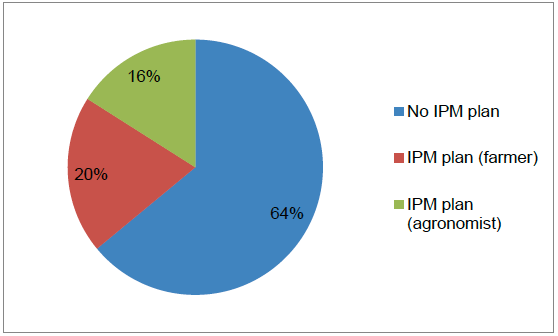
Growers were asked about their IPM activities in relation to three categories; risk management, pest monitoring and pest control. Information was collected about all activities growers conducted in relation to each category. Despite the majority of growers not completing an IPM plan uptake of a wide range of IPM activities was encountered.
Risk management
IPM programs aim to prevent or reduce the risk of pests becoming a threat by minimising the risk of damage occurring that will require subsequent control. Table 48 presents an overview of the risk management measures adopted by the growers surveyed.
Practically all growers (96 per cent) used crop rotation to manage the risk of pest damage. Rotation is a basic principle of farming breaking the link between pathogen and host and reducing pest population build-up. It can also improve soil fertility and structure consequently increasing the vigour of subsequent crops.
The majority of growers (88 per cent) also tested their soils in order to tailor inputs to improve crop performance. Eighty four per cent tested soil nutrient levels with lower proportions testing for disease, nematodes and other soil health parameters ( Figure 41). By pre-emptively testing for nutritional and pest status farmers' can make informed decisions about inputs required and optimal crop choice for that field.
Just over three quarters of growers managed their seed bed agronomy to reduce risk. Around half increased organic matter to improve soil quality while a smaller proportion implemented other measures such as using a stale seed bed (44 per cent) and considering pest management when planning irrigation ( Figure 42).
Just over half of growers amended cultivation methods at sowing to try to increase crop success. Over a third varied sowing dates and 20 per cent varied seed rates to mitigate for potential pest damage. Some growers also used pest free growing media such as coir ( Figure 43).
Almost ninety per cent of the growers surveyed also considered risk management when selecting seeds and/or varieties. Sixty per cent of growers selected pest resistant varieties, where available, to reduce damage. Some growers (24 per cent) also confirmed that they chose to adopt varietal diversification (using a range of different varieties) to increase overall resistance to pests and environmental stresses. Some growers (8 per cent) also reported that they used certified seed which has been tested to ensure it meets quality standards. Just over a third of growers used seed treatments to protect seedlings at crop emergence ( Figure 44).
Over a third of respondents (36 per cent) sowed catch or cover crops as part of their crop production cycle. These crops were cultivated to improve soil quality (28 per cent), manage pests and disease (8 per cent) and suppress weeds (8 per cent). Others (8 per cent) used these crops for biofumgation and to prevent soil erosion.
Finally, 72 per cent of the growers sampled adopted techniques to protect or enhance populations of beneficial insects. Over half left uncultivated strips and 32 per cent planted wild flower strips. Twenty per cent planted pollen sources and 12 per cent took part in agri-environment schemes ( Figure 45).
Table 48 Summary of responses to risk management questions
| Risk management activity | Percentage yes response |
|---|---|
| Crop rotation | 96 |
| Soil testing | 88 |
| Cultivation of seed bed | 76 |
| Cultivations at sowing | 52 |
| Varietal or seed choice | 88 |
| Catch and cover cropping | 36 |
| Protection or enhancement of beneficial organism populations | 72 |
Figure 41 Types of soil testing recorded (percentage of respondents)
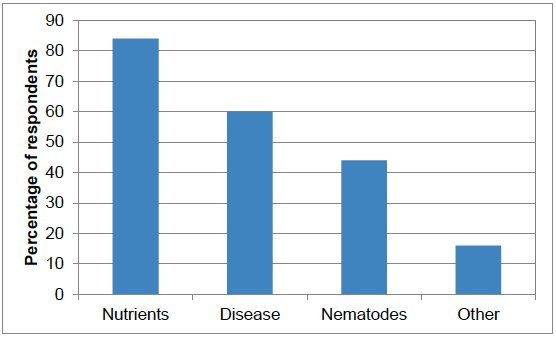
Note: 'other' includes texture, pH, and conductivity.
Figure 42 Methods of cultivating seed bed to reduce pest risk (percentage of respondents)
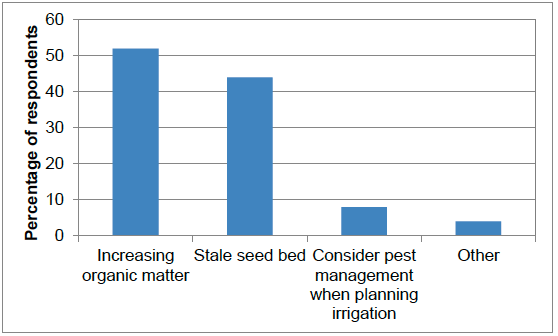
Note: 'other' includes deep ploughing.
Figure 43 Methods of cultivating at sowing to reduce pest risk (percentage of respondents)
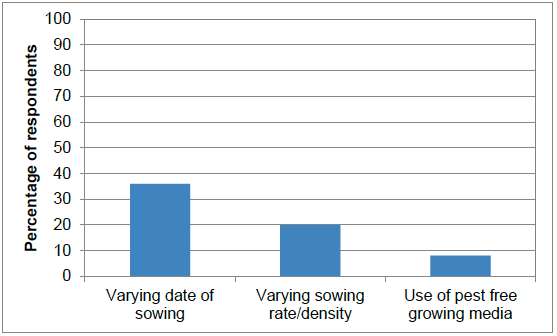
Figure 44 Variety and seed choice to reduce pest risk (percentage of respondents)
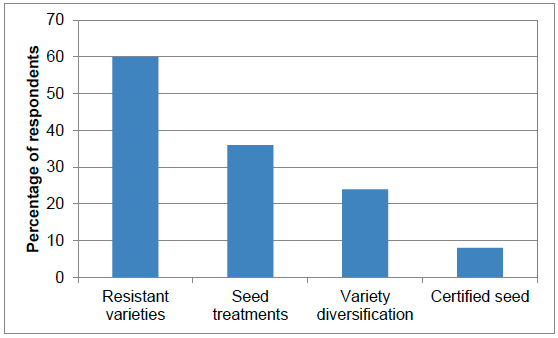
Figure 45 Methods for protecting and enhancing beneficial organism populations (percentage of respondents)
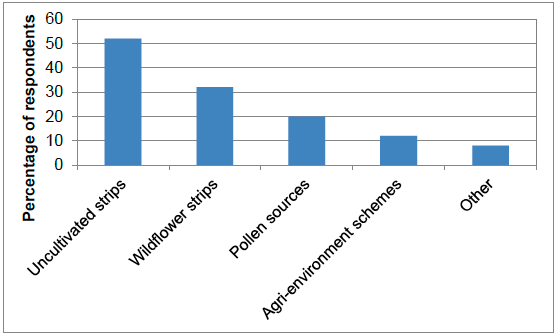
Note: 'other' includes habitat refuges and beetle banks
Pest monitoring
In IPM pests are monitored to determine whether control is economically justified and to be able to effectively target control options. IPM programs aim to monitor and identify pests, so that appropriate control decisions can be made in conjunction with action thresholds. Table 49 presents an overview of the pest monitoring measures adopted by the growers surveyed.
Ninety six per cent of growers regularly monitored crop growth stages and also monitored and identified pests on their crops. Most growers (88 per cent) also used action thresholds when monitoring pest populations. Pest monitoring was by conducted primarily by agronomist inspection (84 per cent) but also by trapping (40 per cent) and by self-inspection (28 per cent). In addition, some growers used risk warnings and technical bulletins to assess pest pressure ( Figure 46).
The majority of respondents (60 per cent) also used specialist diagnostics when dealing with pests that were more problematic to identify or monitor Over half 52 per cent used tissue testing to monitor nutritional deficiencies, 44 per cent used field or pest mapping and 24 per cent used clinic services to identify unknown pests ( Figure 47).
Table 49 Summary of responses to pest monitoring questions
| Pest monitoring activity | Percentage yes response |
|---|---|
| Setting action thresholds for crops | 88 |
| Monitor and identify pests | 96 |
| Use of specialist diagnostics | 60 |
| Regular monitoring of crop growth stage | 96 |
Figure 46 Methods of monitoring and identifying pests (percentage of respondents)
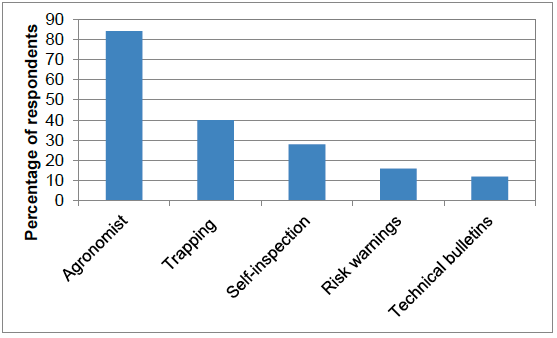
Figure 47 Use of specialist diagnostics (percentage of respondents)
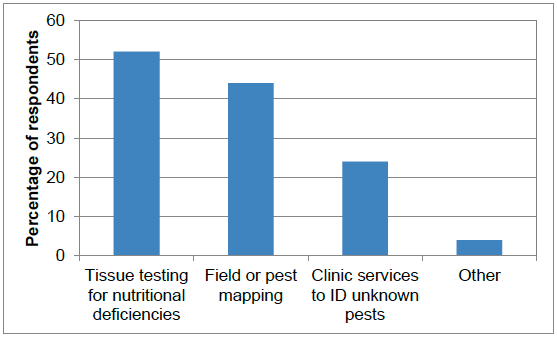
Note: 'other' includes testing for chlorophyll levels
Pest control
If monitoring, identification, and action thresholds indicate that pest control is required, and preventive methods are no longer effective or available, IPM programs evaluate the best control method in relation to effectiveness and risk. Control programmes incorporate non-chemical methods alongside, or instead of, chemical control. Use of chemical pest control should be as targeted as possible and the risk of resistance development should be minimised. The effectiveness of the control programme should be reviewed regularly to gauge success and improve their regime as necessary. Table 50 presents an overview of the pest control measures adopted by the growers surveyed.
The majority of growers (76 per cent) used non-chemical control in partnership or instead of chemical control. A range of control methods were adopted, including use of physical control measures such as using netting (48 per cent), fleece (16 per cent) and mulches (4 per cent) to prevent pest access to the crop and utilising mechanical weeding (36 per cent) as well has chemical control ( Figure 48). Some growers (8 per cent) also used biological control methods.
Seventy six per cent of growers stated that they targeted their pesticide applications using monitoring data. Forty per cent reduced their dosage or frequency of applications where possible, 36 per cent used weed wiping, 20 per cent used spot treatments and 32 per cent used precision application to reduce use ( Figure 49). In addition, 80 per cent of growers stated that they followed anti-resistance strategies. These included 60 per cent both minimising the number of applications and using pesticides with multiple modes of action and 28 percent using pesticides with multi-site modes of action ( Figure 50).
All respondents stated that they monitored the success of their crop protection measures. The methods used included 84 per cent having a regular review by their agronomist, 32 per cent had a seasonal review of practice and 28 per cent used regular self-inspection. Growers also investigated poor pesticide efficacy, used traps to investigate the success of their control methods and received feedback on crop quality from processors and packers ( Figure 51).
Table 50 Summary of responses to pest control questions
| Pest control activity | Percentage yes response |
|---|---|
| Non-chemical control used in partnership or instead of chemical control | 76 |
| Targeted pesticide application | 76 |
| Follow anti-resistance strategies | 80 |
| Monitor success of crop protection measures | 100 |
Figure 48 Types of non-chemical control used (percentage of respondents)
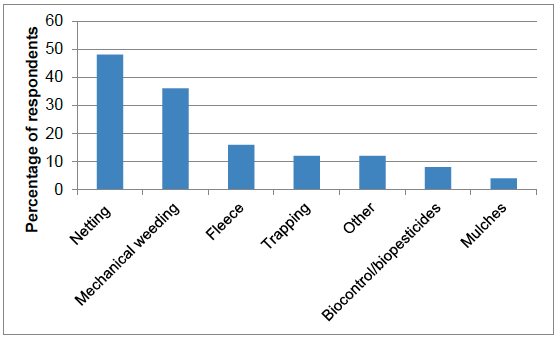
Note: 'other' includes physical controls such as garlic, salt water and vinegar.
Figure 49 Methods of targeting pesticide applications using monitoring data (percentage of respondents)
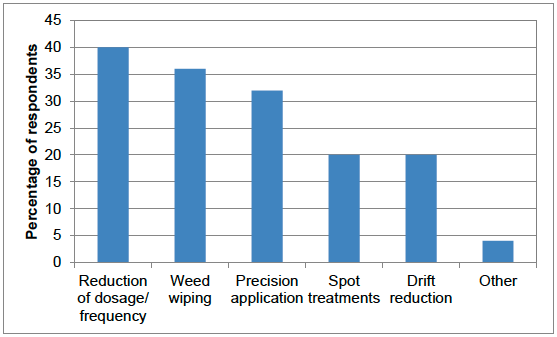
Note: 'other' includes cultivating weeds inter-row.
Figure 50 Types of anti-resistance strategies (percentage of respondents)
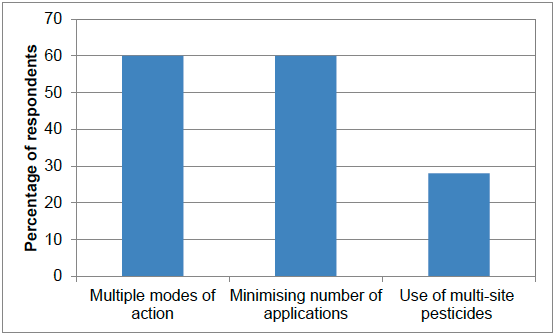
Note: multi-site pesticides each act on different metabolic sites within the target weed, fungus or insect pest, thus increasing their effectiveness.
Figure 51 Methods for monitoring success of crop protection measures (percentage of respondents)
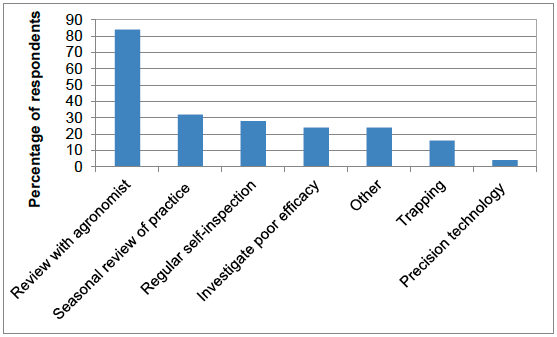
Note: 'other' includes feedback from processors and packers.
Contact
There is a problem
Thanks for your feedback